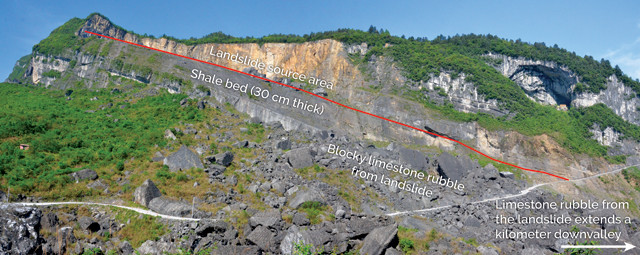
by Mary Caperton Morton Tuesday, March 20, 2018

The Jiweishan landslide began high on these cliffs at the interface between limestone and shale layers, sending tons of rubble into the valley. Credit: Mauri McSaveney.
On June 5, 2009, a catastrophic landslide killed 74 people in southwestern China. But a lack of recent earthquake activity or heavy rainfall left geologists questioning what had triggered the slide. A new study suggests that China’s acid rain may have played a role in weakening the limestone and shale slope in unexpected ways.
The Jiweishan Mountain landslide occurred near Chongqing, China, in the heart of southwest China’s limestone karst region, where rainwater has gradually been dissolving water-soluble limestone for millions of years, creating a dramatic, mountainous landscape cut by steep drainage systems, potholes and caverns. “Even the cleanest rain can attack limestone,” says Ming Zhang, a geoengineer at the China University of Geosciences in Wuhan, and co-author of the new study published in Earth and Planetary Science Letters.
However, China’s widespread air pollution from coal-fired power plants has led to some of the most acidic rain on Earth: Burning coal releases sulfur dioxide, nitrogen dioxide and other pollutants into the atmosphere, where they are assimilated by falling rainwater, creating sulfuric acid and nitric acid. Acid rain typically has a pH under 5, while normal rainfall, which absorbs acidifying carbon dioxide from the atmosphere, measures 5.6. Between 1986 and 2014, the average annual pH of Chongqing’s rainfall varied between 4.3 and 5; at times, the pH dipped as low as 2.8, making it especially corrosive to limestone — and possibly other rocks as well.
Underlying the region’s limestone and dolomite are layers of shell-rich shale, and previous studies showed that the landslide started at the interface between limestone and shale layers, Zhang says. So Zhang and co-author Mauri McSaveney of GNS Science in New Zealand set about testing the effects of acid rainwater percolating down through the limestone to the shale layers.
When they immersed samples of the shale in dilute hydrochloric acid with a pH of 3, the microscopic shell fragments in the shale fizzed and dissolved, leaving behind a weakened rock resembling a porous black sponge. “This shale is described geologically as a bituminous shale, because it contains so much organic matter,” McSaveney says. Once the calcium and magnesium shell fragments were gone, the organic matter was left behind. “We reasoned that if some process could remove the [organic] component, what would be left would be mostly talcum powder, which is soft and slippery” and could be the weak trigger point for the slide.
Zhang and McSaveney then looked for evidence of microbial activity in the shale, McSaveney says, because “we knew that organic matter could be attacked by microbial decay.” DNA tests revealed hundreds of genera of microorganisms, including ones capable of decomposing organic material within the shale and weakening it further.
“Without calcite and organic material, the basal shale at the Jiweishan rock avalanche is composed largely of detrital talc,” the team wrote.
“This is a plausible mechanism for how the effects of acid rain may have accelerated the pace of the decomposition of that shale layer and possibly triggered this slide,” says Richard April, a geochemist at Colgate University in New York who was not involved in the new research. The link between acid rain and landslides is new, April says. “It’s a whole new way of thinking about what might start a landslide.”
April says he does, however, have some reservations about the hypothesized mechanism related to the timescale of acid rain erosion. “In China, the acid rain problem has only peaked in the last 30 years. Can 30 years of acid rain reach the thin shale layer and decompose it to the point that it initiated a landslide?”
Zhang says constraining a timeline for how quickly acid rain can percolate through limestone into the shale layers and determining how much material would need to be dissolved to cause widespread instability between the rock layers are important next steps.
“I would like to see a lot more fieldwork — collecting rainwater, groundwater and rock samples,” April says. Additionally, “more modeling and calculations about how much acid rain has fallen on this region will give a much better idea of whether this is a feasible means of initiating a landslide.”
© 2008-2021. All rights reserved. Any copying, redistribution or retransmission of any of the contents of this service without the expressed written permission of the American Geosciences Institute is expressly prohibited. Click here for all copyright requests.